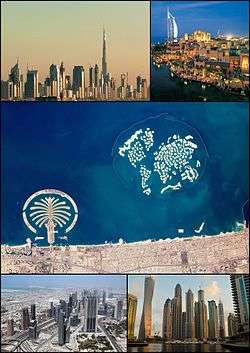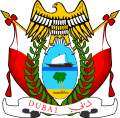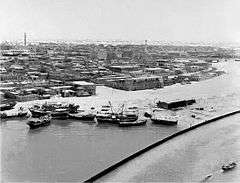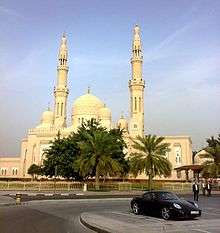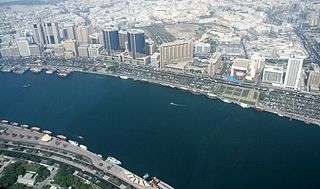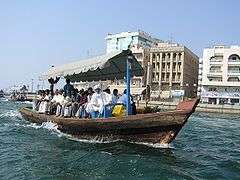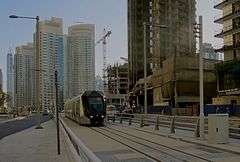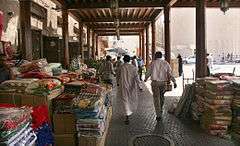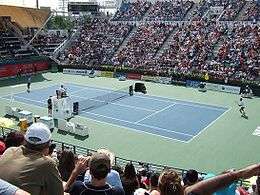Dubai
| Dubai دبي | |||
|---|---|---|---|
| Metropolis | |||
| Dubai | |||
|
Clockwise from top left: skyline with Burj Khalifa; Burj Al Arab; satellite image showing Palm Jumeirah and The World Islands; the Dubai Marina; and Sheik Zayed Road. | |||
| |||
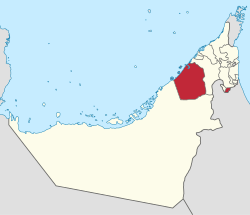 Location of Dubai in United Arab Emirates | |||
| Coordinates: 24°57′N 55°20′E / 24.950°N 55.333°ECoordinates: 24°57′N 55°20′E / 24.950°N 55.333°E | |||
| Country |
| ||
| Emirate |
| ||
| Founded by | Ubaid bin Saeed and Maktum bin Butti Al Maktoum | ||
| Seat | Dubai | ||
| Subdivisions | |||
| Government | |||
| • Type | Absolute monarchy | ||
| • Emir | Mohammed bin Rashid Al Maktoum | ||
| • Crown Prince | Hamdan bin Mohammed bin Rashid Al Maktoum | ||
| Area[1] | |||
| • Metropolis | 4,114 km2 (1,588 sq mi) | ||
| • Urban | 1,287.4 km2 (497.1 sq mi) | ||
| Population (5 November 2016) | |||
| • Metropolis | 2,657,000 | ||
| Time zone | UAE Standard Time (UTC+4) | ||
| GDP (PPP) | 2014 estimate | ||
| Total | US$82.9 billion[2] | ||
| Per capita | US$24,866[2] | ||
| Website |
Dubai Emirate Dubai Municipality Dubai Tourism | ||
Dubai (/duːˈbaɪ/ doo-BY; Arabic: دبي Dubayy, Gulf pronunciation: [dʊˈbɑj]) is the most populous city in the United Arab Emirates (UAE).[3] It is located on the southeast coast of the Persian Gulf and is the capital of the Emirate of Dubai, one of the seven emirates that make up the country. Abu Dhabi and Dubai are the only two emirates to have veto power over critical matters of national importance in the country's legislature.[4] The city of Dubai is located on the emirate's northern coastline and heads up the Dubai-Sharjah-Ajman metropolitan area. Dubai is to host World Expo 2020.[5]
Dubai has emerged as a global city and business hub of the Middle East.[6] It is also a major transport hub for passengers and cargo. By the 1960s, Dubai's economy was based on revenues from trade and, to a smaller extent, oil exploration concessions, but oil was not discovered until 1966. Oil revenue first started to flow in 1969.[7] Dubai's oil revenue helped accelerate the early development of the city, but its reserves are limited and production levels are low: today, less than 5% of the emirate's revenue comes from oil.[8]
The emirate's Western-style model of business drives its economy with the main revenues now coming from tourism, aviation, real estate, and financial services.[9][10][11] Dubai has recently attracted world attention through many innovative large construction projects and sports events. The city has become iconic for its skyscrapers and high-rise buildings, in particular the world's tallest building, the Burj Khalifa. Dubai has been criticised for human rights violations concerning the city's largely South Asian workforce.[12] Dubai's property market experienced a major deterioration in 2008–09 following the financial crisis of 2007–08,[13] but the emirate's economy has made a return to growth, with a projected 2015 budget surplus.[14]
As of 2012, Dubai is the 22nd most expensive city in the world and the most expensive city in the Middle East.[15][16] In 2014, Dubai's hotel rooms were rated as the second most expensive in the world, after Geneva.[17] Dubai was rated as one of the best places to live in the Middle East by U.S. global consulting firm Mercer.[18]
Etymology
Many theories have been proposed as to the origin of the word "Dubai". One theory suggests the word was used to describe the souq, which was similar to the souq in Ba.[19] Another theory states that the name came from a word meaning "money", as people from Dubai were commonly believed to be rich due to the thriving trading centre of the location. An Arabic proverb says "Daba Dubai" (Arabic: دبا دبي), meaning "They came with a lot of money."[20] According to Fedel Handhal, a scholar on the UAE's history and culture, the word Dubai may have come from the word daba (Arabic: دبا) (a past tense derivative of yadub (Arabic: يدب), which means "to creep"), referring to the slow flow of Dubai Creek inland. The poet and scholar Ahmad Mohammad Obaid traces it to the same word, but to its alternative meaning of "baby locust" (Arabic: جراد) due to the abundant nature of locusts in the area before settlement.[21] An inhabitant or native of the city is a Dubaian.[22]
History
Although stone tools have been found at many archaeological sites, little is known about the UAE's early inhabitants as only a few settlements have been found.[23] Many ancient towns in the area were trading centres between the Eastern and Western worlds. The remnants of an ancient mangrove swamp, dated at 7000 BC, were discovered during the construction of sewer lines near Dubai Internet City. The area was covered with sand about 5,000 years ago as the coast retreated inland, becoming part of the city's present coastline.[23][24] Pre-Islamic ceramics have been found from the 3rd and 4th centuries.[25] Prior to the introduction of Islam to the area, the people in this region worshiped Bajir (or Bajar).[25] After the spread of Islam in the region, the Umayyad Caliph of the eastern Islamic world invaded south-east Arabia and drove out the Sassanians. Excavations by the Dubai Museum in the region of Al-Jumayra (Jumeirah) found several artefacts from the Umayyad period.[26]
The earliest recorded mention of Dubai is in 1095 in the Book of Geography by the Andalusian-Arab geographer Abu Abdullah al-Bakri. The Venetian pearl merchant Gaspero Balbi visited the area in 1580 and mentioned Dubai (Dibei) for its pearling industry.[26]
Dubai is thought to have been established as a fishing village in the early 18th century[27] and was, by 1822, a town of some 7–800 members of the Baniyas tribe and subject to the rule of Sheikh Tahnoon of Abu Dhabi.[28]
In 1833, following tribal feuding, members of the Al Bu Falasa tribe seceded from Abu Dhabi and established themselves in Dubai. The exodus from Abu Dhabi was led by Ubaid bin Saeed and Maktum bin Butti who became joint leaders of Dubai until Ubaid died in 1836, leaving Maktum to establish the Maktoum dynasty.[27]
Dubai signed the treaty of 'Perpetual Maritime Truce' of 1853 along with other Trucial States and also – like its neighbours on the Trucial Coast – entered into an exclusivity agreement in which the United Kingdom took responsibility for the emirate's security in 1892.
Two catastrophes struck the town during the 1800s. First, in 1841, a smallpox epidemic broke out in the Bur Dubai locality, forcing residents to relocate east to Deira. Then, in 1894, fire swept through Deira, burning down most homes.[29] However, the town's geographical location continued to attract traders and merchants from around the region. The emir of Dubai was keen to attract foreign traders and lowered trade tax brackets, which lured traders away from Sharjah and Bandar Lengeh, the region's main trade hubs at the time. Persian merchants naturally looked across to the Arab shore of the Persian Gulf finally making their homes in Dubai. They continued to trade with Lingah, however, as do many of the dhows in Dubai Creek today, and they named their district Bastakiya, after the Bastak region in southern Persia.[29][30]
Pre-oil Dubai
Dubai's geographical proximity to Iran made it an important trade location. The town of Dubai was an important port of call for foreign tradesmen, chiefly those from Iran, many of whom eventually settled in the town. By the beginning of the 20th century, it was an important port.[31]
Dubai was known for its pearl exports until the 1930s; the pearl trade was damaged irreparably by the Great Depression in the 1930s and the innovation of cultured pearls. With the collapse of the pearling industry, Dubai fell into a deep depression and many residents starved or migrated to other parts of the Persian Gulf.[23]
In the early days since its inception, Dubai was constantly at odds with Abu Dhabi. In 1947, a border dispute between Dubai and Abu Dhabi on the northern sector of their mutual border escalated into war.[32] Arbitration by the British and the creation of a buffer frontier running south eastwards from the coast at Ras Hasian resulted in a temporary cessation of hostilities.[33]
Despite a lack of oil, Dubai's ruler from 1948, Sheikh Rashid bin Saeed Al Maktoum, used revenue from trading activities to build infrastructure. Electricity, telephone services, and an airport were established in Dubai in the 1950s and, in 1959, the emirate's first hotel, the Airlines Hotel, was constructed. This was followed by the Ambassador and Carlton Hotel in 1968.[34]
On 7 April 1961, the Dubai-based MV Dara, a five thousand ton British flagged vessel that plied the route between Basra (Iraq), Kuwait and Bombay (India), was caught in unusually high winds off Dubai. Early the next morning in heavy seas off Umm Al Qawain, an explosion tore out the second class cabins and started fires. The captain gave the order to abandon ship but two lifeboats capsized and a second explosion occurred. A flotilla of small boats from Dubai, Sharjah, Ajman and Umm Al Qawain picked up survivors but in all 238 lives were lost in the disaster.
In 1962 the British Political Agent noted that "Many new houses and blocks of offices and flats are being built... the Ruler is determined, against advice [from the British] to press on with the construction of a jet airport... More and more European and Arab firms are opening up and the future looks bright."[34]
The asphalt runway was constructed in 1965, opening Dubai to both regional and long haul traffic. In 1970 a new terminal building was constructed which included Dubai's first duty-free shops.[35]
Oil era
After years of exploration following large finds in neighbouring Abu Dhabi, oil was eventually discovered in territorial waters off Dubai in 1966, albeit in far smaller quantities. The first field was named 'Fateh' or 'good fortune'. This led the emirate to grant concessions to international oil companies, thus leading to a massive influx of foreign workers, mainly Asians and Middle easterners. Between 1968 and 1975 the city's population grew by over 300%.[36]
As part of the infrastructure for pumping and transporting oil from the Fateh field, located offshore of the Jebel Ali area of Dubai, a number of 50,000 gallon storage tanks were built, known locally as 'Kazzans',[37] by welding them together on the beach and then digging them out and floating them to drop onto the seabed at the Fateh field. These were constructed by the Chicago Bridge and Iron Company, which gave the beach its local name (Chicago Beach) until the Chicago Beach Hotel was demolished and replaced by the Jumeirah Beach Hotel in the late nineties.
Dubai had already embarked on a period of infrastructural development and expansion. Oil revenue, flowing from 1969 onwards supported a period of growth with Sheikh Rashid embarking on a policy of building infrastructure and a diversified trading economy before the emirate's limited reserves were depleted. Oil accounted for 24% of GDP in 1990, but had reduced to 7% of GDP by 2004.[7]
Critically, one of the first major projects Sheikh Rashid embarked upon when oil revenue started to flow was the construction of Port Rashid, a deep water free port constructed by British company Halcrow. Originally intended to be a four-berth port, it was extended to sixteen berths as construction was ongoing. The project was an outstanding success, with shipping queuing to access the new facilities. The port was inaugurated on 5 October 1972, although its berths were each pressed into use as soon as they had been built. Port Rashid was to be further expanded in 1975 to add a further 35 berths before the larger port of Jebel Ali was constructed.[7]
Port Rashid was the first of a swathe of projects designed to create a modern trading infrastructure, including roads, bridges, schools and hospitals.[38]
Reaching the UAE's Act of Union
Dubai and the other 'trucial states' had long been a British protectorate where the British took care of foreign policy and defence, as well as arbitrating between the rulers of the Eastern Gulf. This was to change with PM Harold Wilson's announcement, on 16 January 1968, that all British troops were to be withdrawn from 'East of Aden'. The decision was to pitch the coastal emirates, together with Qatar and Bahrain, into fevered negotiations to fill the political vacuum that the British withdrawal would leave behind.[39]
The principle of union was first agreed between the ruler of Abu Dhabi, Sheikh Zayed bin Sultan Al Nahyan, and Sheikh Rashid of Dubai on 18 February 1968 meeting in an encampment at Argoub Al Sedirah, near Al Semeih, a desert stop between the two emirates.[40] The two agreed to work towards bringing the other emirates, including Qatar and Bahrain, into the union. Over the next two years, negotiations and meetings of the rulers followed -often stormy- as a form of union was thrashed out. The nine-state union was never to recover from the October 1969 meeting where heavy-handed British intervention resulted in a walk-out by Qatar and Ras Al Khaimah.[34] Bahrain and Qatar were to drop out of talks, leaving only six emirates to agree on union on 18 July 1971.
On 2 December 1971, Dubai, together with Abu Dhabi, Sharjah, Ajman, Umm Al Qawain and Fujairah joined in the Act of Union to form the United Arab Emirates. The seventh emirate, Ras Al Khaimah, joined the UAE on 10 February 1972, following giant non-Arab neighbour Iran's annexation of the RAK-owned Tunbs islands.
In 1973, Dubai joined the other emirates to adopt a uniform currency: the UAE dirham.[31] In that same year, the prior monetary union with Qatar was dissolved and the UAE Dirham was introduced throughout the Emirates.
Modern Dubai
During the 1970s, Dubai continued to grow from revenues generated from oil and trade, even as the city saw an influx of immigrants fleeing the Lebanese civil war.[41] Border disputes between the emirates continued even after the formation of the UAE; it was only in 1979 that a formal compromise was reached that ended disagreements.[42] The Jebel Ali port was established in 1979. JAFZA (Jebel Ali Free Zone) was built around the port in 1985 to provide foreign companies unrestricted import of labour and export capital.[43] Dubai airport and the aviation industry also continued to grow.
The Gulf War of 1990 had a negative financial effect on the city, as depositors withdrew their money and traders withdrew their trade, but subsequently, the city recovered in a changing political climate and thrived. Later in the 1990s, many foreign trading communities—first from Kuwait, during the Gulf War, and later from Bahrain, during the Shia unrest—moved their businesses to Dubai.[30] Dubai provided refuelling bases to allied forces at the Jebel Ali Free Zone during the Gulf War, and again during the 2003 Invasion of Iraq. Large increases in oil prices after the Gulf War encouraged Dubai to continue to focus on free trade and tourism.[44]
Geography
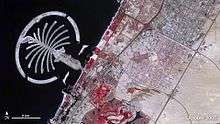
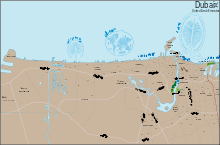
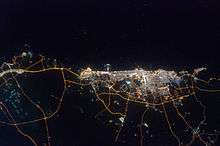
Dubai is situated on the Persian Gulf coast of the United Arab Emirates and is roughly at sea level (16 m or 52 ft above). The emirate of Dubai shares borders with Abu Dhabi in the south, Sharjah in the northeast, and the Sultanate of Oman in the southeast. Hatta, a minor exclave of the emirate, is surrounded on three sides by Oman and by the emirates of Ajman (in the west) and Ras Al Khaimah (in the north). The Persian Gulf borders the western coast of the emirate. Dubai is positioned at 25°16′11″N 55°18′34″E / 25.2697°N 55.3095°E and covers an area of 1,588 sq mi (4,110 km2), which represents a significant expansion beyond its initial 1,500 sq mi (3,900 km2) designation due to land reclamation from the sea.
Dubai lies directly within the Arabian Desert. However, the topography of Dubai is significantly different from that of the southern portion of the UAE in that much of Dubai's landscape is highlighted by sandy desert patterns, while gravel deserts dominate much of the southern region of the country.[45] The sand consists mostly of crushed shell and coral and is fine, clean and white. East of the city, the salt-crusted coastal plains, known as sabkha, give way to a north-south running line of dunes. Farther east, the dunes grow larger and are tinged red with iron oxide.[36]
The flat sandy desert gives way to the Western Hajar Mountains, which run alongside Dubai's border with Oman at Hatta. The Western Hajar chain has an arid, jagged and shattered landscape, whose mountains rise to about 1,300 metres (4,265 feet) in some places. Dubai has no natural river bodies or oases; however, Dubai does have a natural inlet, Dubai Creek, which has been dredged to make it deep enough for large vessels to pass through. Dubai also has multiple gorges and waterholes, which dot the base of the Western Al Hajar mountains. A vast sea of sand dunes covers much of southern Dubai and eventually leads into the desert known as The Empty Quarter. Seismically, Dubai is in a very stable zone—the nearest seismic fault line, the Zagros Fault, is 200 kilometres (124 miles) from the UAE and is unlikely to have any seismic impact on Dubai.[46] Experts also predict that the possibility of a tsunami in the region is minimal because the Persian Gulf waters are not deep enough to trigger a tsunami.[46]
The sandy desert surrounding the city supports wild grasses and occasional date palms. Desert hyacinths grow in the sabkha plains east of the city, while acacia and ghaf trees grow in the flat plains within the proximity of the Western Al Hajar mountains. Several indigenous trees such as the date palm and neem as well as imported trees such as the eucalypts grow in Dubai's natural parks. The houbara bustard, striped hyena, caracal, desert fox, falcon and Arabian oryx are common in Dubai's desert. Dubai is on the migration path between Europe, Asia and Africa, and more than 320 migratory bird species pass through the emirate in spring and autumn. The waters of Dubai are home to more than 300 species of fish, including the hammour. The typical marine life off the Dubai coast includes tropical fish, jellyfish, coral, dugong, dolphins, whales and sharks. Various types of turtles can also be found in the area including the hawksbill turtle and green turtle, which are listed as endangered species.[47][48]
Dubai Creek runs northeast-southwest through the city. The eastern section of the city forms the locality of Deira and is flanked by the emirate of Sharjah in the east and the town of Al Aweer in the south. The Dubai International Airport is located south of Deira, while the Palm Deira is located north of Deira in the Persian Gulf. Much of Dubai's real-estate boom is concentrated to the west of Dubai Creek, on the Jumeirah coastal belt. Port Rashid, Jebel Ali, Burj Al Arab, the Palm Jumeirah and theme-based free-zone clusters such as Business Bay are all located in this section.
Climate
Dubai has a hot desert climate. Summers in Dubai are extremely hot, windy, and humid, with an average high around 41 °C (106 °F) and overnight lows around 30 °C (86 °F) in the hottest month, August. Most days are sunny throughout the year. Winters are warm with an average high of 24 °C (75 °F) and overnight lows of 14 °C (57 °F) in January, the coldest month. Precipitation, however, has been increasing in the last few decades, with accumulated rain reaching 94.3 mm (3.71 in) per year.[49] Dubai summers are also known for the moderate to high humidity level, which can make it uncomfortable for many.[50] The highest recorded temperature in the UAE is 52.1 °C (126 °F), reached in July 2002.[51]
| Climate data for Dubai | |||||||||||||
|---|---|---|---|---|---|---|---|---|---|---|---|---|---|
| Month | Jan | Feb | Mar | Apr | May | Jun | Jul | Aug | Sep | Oct | Nov | Dec | Year |
| Record high °C (°F) | 31.6 (88.9) |
37.5 (99.5) |
41.3 (106.3) |
43.5 (110.3) |
47.0 (116.6) |
46.7 (116.1) |
52.1 (125.8) |
48.7 (119.7) |
45.1 (113.2) |
42.0 (107.6) |
41.0 (105.8) |
35.5 (95.9) |
52.1 (125.8) |
| Average high °C (°F) | 23.9 (75) |
25.4 (77.7) |
28.4 (83.1) |
33.0 (91.4) |
37.7 (99.9) |
39.5 (103.1) |
40.9 (105.6) |
41.3 (106.3) |
38.9 (102) |
35.4 (95.7) |
30.6 (87.1) |
26.2 (79.2) |
33.4 (92.1) |
| Average low °C (°F) | 14.3 (57.7) |
15.5 (59.9) |
17.7 (63.9) |
21.0 (69.8) |
25.1 (77.2) |
27.3 (81.1) |
30.0 (86) |
30.4 (86.7) |
27.7 (81.9) |
24.1 (75.4) |
20.1 (68.2) |
16.3 (61.3) |
22.5 (72.5) |
| Record low °C (°F) | 6.1 (43) |
6.9 (44.4) |
9.0 (48.2) |
13.4 (56.1) |
15.1 (59.2) |
18.2 (64.8) |
20.4 (68.7) |
23.1 (73.6) |
16.5 (61.7) |
15.0 (59) |
11.8 (53.2) |
8.2 (46.8) |
6.1 (43) |
| Average precipitation mm (inches) | 18.8 (0.74) |
25.0 (0.984) |
22.1 (0.87) |
7.2 (0.283) |
0.4 (0.016) |
0.0 (0) |
0.8 (0.031) |
0.0 (0) |
0.0 (0) |
1.1 (0.043) |
2.7 (0.106) |
16.2 (0.638) |
94.3 (3.711) |
| Average precipitation days | 5.4 | 4.7 | 5.8 | 2.6 | 0.3 | 0.0 | 0.5 | 0.5 | 0.1 | 0.2 | 1.3 | 3.8 | 25.2 |
| Average relative humidity (%) | 65 | 65 | 63 | 55 | 53 | 58 | 56 | 57 | 60 | 60 | 61 | 64 | 59.8 |
| Mean monthly sunshine hours | 254.2 | 229.6 | 254.2 | 294.0 | 344.1 | 342.0 | 322.4 | 316.2 | 309.0 | 303.8 | 285.0 | 254.2 | 3,508.7 |
| Source #1: Dubai Meteorological Office[52] | |||||||||||||
| Source #2: climatebase.ru (extremes, sun),[53] NOAA (humidity, 1974–1991)[54] | |||||||||||||
| Jan | Feb | Mar | Apr | May | Jun | Jul | Aug | Sep | Oct | Nov | Dec |
|---|---|---|---|---|---|---|---|---|---|---|---|
| 23.4 °C (74.1 °F) | 21.9 °C (71.4 °F) | 23.2 °C (73.8 °F) | 25.5 °C (77.9 °F) | 28.8 °C (83.8 °F) | 31.6 °C (88.9 °F) | 32.7 °C (90.9 °F) | 33.5 °C (92.3 °F) | 33.1 °C (91.6 °F) | 31.3 °C (88.3 °F) | 28.6 °C (83.5 °F) | 25.4 °C (77.7 °F) |
Governance and politics
Dubai has been ruled by the Al Maktoum family since 1833; the emirate is an absolute monarchy with no elections (other than the few thousand Dubai citizens participating in the electoral college for the Federal National Council of the UAE). The ruler, Mohammed bin Rashid Al Maktoum, is also the Vice President and Prime Minister of the United Arab Emirates and member of the Supreme Council of the Union (SCU). Dubai appoints 8 members in two-term periods to the Federal National Council (FNC) of the UAE, the supreme federal legislative body.[56]
The Dubai Municipality (DM) was established by the then-ruler of Dubai, Rashid bin Saeed Al Maktoum, in 1954 for purposes of city planning, citizen services and upkeep of local facilities.[57] DM is chaired by Hamdan bin Rashid Al Maktoum, deputy ruler of Dubai, and comprises several departments such as the Roads Department, Planning and Survey Department, Environment and Public Health Department and Financial Affairs Department. In 2001, Dubai Municipality embarked on an e-Government project with the intention of providing 40 of its city services through its web portal, [ dubai.ae]. Thirteen such services were launched by October 2001, while several other services were expected to be operational in the future.[58] Dubai Municipality is also in charge of the city's sanitation and sewage infrastructure.[59]
The UAE has a Minister of Happiness, appointed by his High Highness Sheikh Mohammed Bin Rashid Al Maktoum. The UAE has also appointed a Minister of Tolerance to promote tolerance as a fundamental value of the UAE, a country filled with a diverse range of faiths and ethnicities,[60] and also a Minister for Youth Affairs.
Law enforcement
The Dubai Police Force, founded in 1956 in the locality of Naif, has law enforcement jurisdiction over the emirate. The force is under direct command of Mohammed bin Rashid al Maktoum, ruler of Dubai.
Dubai and Ras al Khaimah are the only emirates that do not conform to the federal judicial system of the United Arab Emirates.[61] The emirate's judicial courts comprise the Court of First Instance, the Court of Appeal, and the Court of Cassation. The Court of First Instance consists of the Civil Court, which hears all civil claims; the Criminal Court, which hears claims originating from police complaints; and Sharia Court, which is responsible for matters between Muslims. Non-Muslims do not appear before the Sharia Court. The Court of Cassation is the supreme court of the emirate and hears disputes on matters of law only.[62]
Sharia laws
The laws concerning sexual morality restrict public and private acts.
Kissing in certain places is illegal and can result in deportation.[63][64][65][66][67][68]
Sometimes, certain narrow exemptions to Islamic law are made for adult non-Muslims.
Adult non-Muslims are allowed to consume alcohol in licensed venues, typically within hotels, or at home with the possession of an alcohol license. Restaurants outside hotels in Dubai are typically not permitted to sell alcohol.[69] Like other parts of the world, drinking and driving is not legal.
Dress code
The Emirati attire is typical of several countries in the Arabian peninsula. Women usually wear the "Abaya", a long black robe with a hijab (the head-scarf which covers the neck and part of the head). Some women may add a niqab which cover the mouth and nose and only leaves the eyes exposed. Men wear the "Kandurah" also referred to as "dishdasha" or even "thawb" (long white robe) and the headscarf (Ghotrah). The UAE traditional Ghotrah is white and is held in place by an accessory called "Egal", which resembles a black cord. The younger Emiraties prefer to wear red and white Ghotras and tie it round their head like a turban.
The above dress code is not compulsory and many people wear western or other eastern clothing without any problems; but prohibitions on wearing "indecent clothing" or revealing too much skin are aspects of the UAE to which Dubai's visitors are expected to conform, and are encoded in Dubai's criminal law.[70] The UAE has enforced anti-indecency prohibitions in all public places (aside from waterparks, beaches, clubs, and bars).
Human rights
Human rights organisations have heavily criticised violations of human rights in Dubai.[71]
In Dubai homosexuality is illegal. This leads to major discrimination and governmental punishments based on sexual orientation, as in most middle eastern countries (except Israel, Jordan (de jure) and Turkey).
Some of the 250,000 foreign labourers in the city have been alleged to live in conditions described by Human Rights Watch as "less than humane".[72][73][74][75] The mistreatment of foreign workers was a subject of the difficult-to-make documentary, Slaves in Dubai (2009).[76] The Dubai government has denied labour injustices and stated that the watchdog's (Human Rights Watch) accusations were 'misguided'. The filmmaker explained in interviews how it was necessary to go undercover to avoid discovery by the authorities, who impose high fines on reporters attempting to document human rights abuses, including the conditions of construction workers. Towards the end of March 2006, the government had announced steps to allow construction unions. UAE labour minister Ali al-Kaabi said: "Labourers will be allowed to form unions."[77]
Demographics
| Historical population | ||
|---|---|---|
| Year | Pop. | ±% |
| 1822[78] | 1,200 | — |
| 1900[79] | 10,000 | +733.3% |
| 1930[80] | 20,000 | +100.0% |
| 1940[78] | 38,000 | +90.0% |
| 1960[81] | 40,000 | +5.3% |
| 1968[82] | 58,971 | +47.4% |
| 1975[83] | 183,000 | +210.3% |
| 1985[84] | 370,800 | +102.6% |
| 1995[84] | 674,000 | +81.8% |
| 2005 | 1,204,000 | +78.6% |
| 2014 | 2,250,000 | +86.9% |
| 2016 | 2,502,715 | +11.2% |
| c-census; e-estimate | ||
Ethnicity and languages
According to the census conducted by the Statistics Centre of Dubai, the population of the emirate was 1,771,000 as of 2009, which included 1,370,000 males and 401,000 females.[85] The region covers 1,287.5 square kilometres (497.1 sq mi). The population density is 408.18/km2 – more than eight times that of the entire country. Dubai is the second most expensive city in the region and 20th most expensive city in the world.[86]
As of 2013, only about 15% of the population of the emirate was made up of UAE nationals,[87] with the rest comprising expatriates, many of whom either have been in the country for generations or were born in the UAE.[88][89] Approximately 85% of the expatriate population (and 71% of the emirate's total population) was Asian, chiefly Indian (51%) and Pakistani (16%); other significant Asian groups include Bangladeshis (9%) and Filipinos (3%). There is a sizable community of Somalis numbering around 30,000, as well as other communities of various nationalities.[90] A quarter of the population (local and foreign) reportedly traces their origins to Iran.[91] In addition, 16% of the population (or 288,000 persons) living in collective labour accommodation were not identified by ethnicity or nationality, but were thought to be primarily Asian.[92] There are over 100,000 British expatriates in Dubai, by far the largest group of Western expatriates in the city.[93] The median age in the emirate was about 27 years. In 2014, there were estimated to be 15.54 births and 1.99 deaths per 1,000 people.[94] There are other Arab nationals, including GCC nationals.
Arabic is the national and official language of the United Arab Emirates. The Gulf dialect of Arabic is spoken natively by the Emirati people.[95] English is used as a second language. Other major languages spoken in Dubai due to immigration are Malayalam, Hindi-Urdu (or Hindustani), Gujarati, Persian, Sindhi, Tamil, Punjabi, Pashto, Bengali, Balochi, Tulu,[96] Kannada, Sinhala, Marathi, Telugu, Tagalog and Chinese, in addition to many other languages.[97]
Religion
Article 7 of the UAE's Provisional Constitution declares Islam the official state religion of the UAE. The government subsidises almost 95% of mosques and employs all Imams; approximately 5% of mosques are entirely private, and several large mosques have large private endowments.[98] All mosques in Dubai are managed by the Islamic Affairs and Charitable Activities Department also known as "Awqaf" under the Government of Dubai and all Imams are appointed by the Government.[99] Any person held preaching racism , religious hatred or promoting religious extremism is usually jailed and deported.
Minorities
Dubai also has large Christian, Hindu, Sikh, Bahá'í, Buddhist and other religious communities residing in the city.[100]
Non-Muslim groups can own their own houses of worship, where they can practice their religion freely, by requesting a land grant and permission to build a compound. Groups that do not have their own buildings must use the facilities of other religious organisations or worship in private homes.[101] Non-Muslim religious groups are permitted to advertise group functions openly and distribute various religious literature; however, outright proselytising is strictly prohibited under penalty of criminal prosecution, imprisonment and deportation for engaging in behaviour offensive to Islam.[98] Strict prohibition extends to small groups such as the Ahmadiyya. Catholics have no proper jurisdiction in the UAE, but are served pastorally by the Apostolic Vicariate of Southern Arabia.
Economy
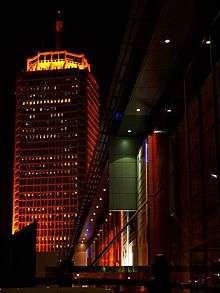
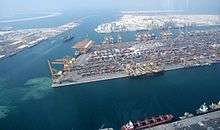
One of the world's fastest growing economies,[102] Dubai's gross domestic product is projected at US$107.1 billion, with a growth rate of 6.1% in 2014.[103] Although a number of core elements of Dubai's trading infrastructure were built on the back of the oil industry,[104] revenues from oil and natural gas account for less than 5% of the emirate's revenues.[9] It is estimated that Dubai produces 50,000 to 70,000 barrels (7,900 to 11,100 m3) of oil a day[105] and substantial quantities of gas from offshore fields. The emirate's share in the UAE's total gas revenues is about 2%. Dubai's oil reserves have diminished significantly and are expected to be exhausted in 20 years.[106] Real estate and construction (22.6%),[11] trade (16%), entrepôt (15%) and financial services (11%) are the largest contributors to Dubai's economy.[107]
Dubai’s non-oil foreign trade stood at $362 billion in 2014. Of the overall trade volumes, imports had the biggest share with a value of $230 billion while exports and re-exports to the emirate stood at $31 billion and $101 billion respectively.[108]
By 2014, China had emerged as Dubai's largest international trading partner, with a total of $47.7 billion in trade flows, up 29% from 2013. India was second among Dubai’s key trading partners with a trade of $29.7 billion, followed by the United States at $22.62 billion. The Kingdom of Saudi Arabia was Dubai’s fourth trading partner globally and first in the GCC and Arab world with a total trade value of $14.2 billion. Trade with Germany in 2014 totalled $12.3, Switzerland and Japan both at $11.72 billion and UK trade totalled $10.9 billion.[108]
Historically, Dubai and its twin across Dubai Creek, Deira (independent of Dubai City at that time), were important ports of call for Western manufacturers. Most of the new city's banking and financial centres were headquartered in the port area. Dubai maintained its importance as a trade route through the 1970s and 1980s. Dubai has a free trade in gold and, until the 1990s, was the hub of a "brisk smuggling trade"[31] of gold ingots to India, where gold import was restricted. Dubai's Jebel Ali port, constructed in the 1970s, has the largest man-made harbour in the world and was ranked seventh globally for the volume of container traffic it supports.[109] Dubai is also a hub for service industries such as information technology and finance, with industry-specific free zones throughout the city.[110] Dubai Internet City, combined with Dubai Media City as part of TECOM (Dubai Technology, Electronic Commerce and Media Free Zone Authority), is one such enclave, whose members include IT firms such as Hewlett-Packard, EMC Corporation, Oracle Corporation, Microsoft, Dell and IBM, and media organisations such as MBC, CNN, BBC, Reuters, Sky News and AP.
The government's decision to diversify from a trade-based, oil-reliant economy to one that is service- and tourism-oriented made property more valuable, resulting in the property appreciation from 2004 to 2006. A longer-term assessment of Dubai's property market, however, showed depreciation; some properties lost as much as 64% of their value from 2001 to November 2008.[111] The large-scale real estate development projects have led to the construction of some of the tallest skyscrapers and largest projects in the world such as the Emirates Towers, the Burj Khalifa, the Palm Islands and the most expensive hotel, the Burj Al Arab.[112] Dubai's property market experienced a major downturn in 2008[113] and 2009 as a result of the slowing economic climate.[13] By early 2009, the situation had worsened with the Great Recession taking a heavy toll on property values, construction and employment.[114] This has had a major impact on property investors in the region, some of whom were unable to release funds from investments made in property developments.[115] As of February 2009, Dubai's foreign debt was estimated at approximately $80 billion, although this is a tiny fraction of the sovereign debt worldwide.[116] Dubai real estate and UAE property experts believe that by avoiding the mistakes of the past, Dubai's realty market can achieve stability in the future.[117]
The Dubai Financial Market (DFM) was established in March 2000 as a secondary market for trading securities and bonds, both local and foreign. As of fourth quarter 2006, its trading volume stood at about 400 billion shares, worth $95 billion in total. The DFM had a market capitalisation of about $87 billion.[92] The other Dubai-based stock exchange is NASDAQ Dubai, which is the international stock exchange in the Middle East. It enables a range of companies, including UAE and regional small and medium-sized enterprises, to trade on an exchange with an international brand name, with access by both regional and international investors.
Dubai is also known as the City of Gold, because a major part of the economy is based on gold trades, with Dubai's total gold trading volumes in H1 2011 reaching 580 tonnes, with an average price of US$1,455 per troy ounce.[118]
A City Mayors survey ranked Dubai 44th among the world's best financial cities in 2007,[119] while another report by City Mayors indicated that Dubai was the world's 27th richest city in 2012, in terms of purchasing power parity (PPP).[120] Dubai is also an international financial centre (IFC) and has been ranked 37th within the top 50 global financial cities as surveyed by the MasterCard Worldwide Centres of Commerce Index (2007),[121] and 1st within the Middle East. Since it opened in September 2004, the Dubai IFC has attracted, as a regional hub, leading international firms and set-up the NASDAQ Dubai which lists equity, derivatives, structured products, Islamic bonds (sukuk) and other bonds. The Dubai IFC model is an independent risk-based regulator with a legislative system consistent with English common law.[122]
In 2012, the Global City Competitiveness Index by the Economist Intelligence Unit ranked Dubai at No. 40 with a total score of 55.9. According to its 2013 research report on the future competitiveness of cities, in 2025, Dubai will have moved up to 23rd place overall in the Index.[123] Indians, followed by Britons and Pakistanis are the top foreign investors in Dubai realty.[124]
Dubai has launched several major projects to support its economy and develop different sectors. These include Dubai Fashion 2020,[125] and Dubai Design District, expected to become a home to leading local and international designers. The AED 4 billion first phase of the project will be complete by January 2015.[126]
Tourism and retail
Tourism is an important part of the Dubai government's strategy to maintain the flow of foreign cash into the emirate. Dubai's lure for tourists is based mainly on shopping,[127][128] but also on its possession of other ancient and modern attractions. As of 2013, Dubai was the 7th most visited city of the world based on air traffic and the fastest growing, increasing by a 10.7% rate.[129] Dubai is expected to accommodate over 15 million tourists by 2015.[130] The emirate is also the most populous of the seven emirates of the United Arab Emirates.
Dubai has been called the "shopping capital of the Middle East".[131] Dubai alone has more than 70 shopping centres, including the world's largest shopping centre, Dubai Mall. Dubai is also known for the traditional souk districts located on either side of its creek. Traditionally, dhows from East Asia, China, Sri Lanka, and India would discharge their cargo and the goods would be bargained over in the souks adjacent to the docks. Dubai Creek played a vital role in sustaining the life of the community in the city and was the resource which originally drove the economic boom in Dubai.[132] As of September 2013, Dubai creek has been proposed as a UNESCO World Heritage Site.[133] Many boutiques and jewellery stores are also found in the city. Dubai is also referred to as "the City of Gold" as the Gold Souk in Deira houses nearly 250 gold retail shops.[134]
Dubai Creek Park in Dubai Creek also plays a vital role in Dubai tourism as it showcase some of the most famous tourist attractions in Dubai such as Dolphinarium, Cable Car, Camel Ride, Horse Carriage and Exotic Birds Shows.[135]
Expo 2020
On 2 November 2011, four cities had their bids for Expo 2020 already lodged, with Dubai making a last-minute entry. The delegation from the Bureau International des Expositions, which visited Dubai in February 2013 to examine the Emirate’s readiness for the largest exposition, was impressed by the infrastructure and the level of national support. In May 2013, Dubai Expo 2020 Master Plan was revealed.[136] Dubai then won the right to host Expo 2020 on 27 November 2013.[137] The event will bring huge economic benefits by generating activities worth billions of dirhams and may create over 270,000 jobs.[138] The main site of Dubai Expo 2020 will be a 438-hectare area (1,083 acres), part of the new Dubai Trade Centre Jebel Ali urban development, located midway between Dubai and Abu Dhabi.[139] Moreover, the Expo 2020 also created various social enlistment projects and monetary boons to the city targeting the year 2020. Such as initiating the world’s largest solar project,[140] the real estate upsurge, to focus on the GDP growth and to make Dubai a “Happy Dubai” for the people of the city.[141]
Cityscape

Architecture

Dubai has a rich collection of buildings and structures of various architectural styles. Many modern interpretations of Islamic architecture can be found here, due to a boom in construction and architectural innovation in the Arab World in general, and in Dubai in particular, supported not only by top Arab or international architectural and engineering design firms such as Al Hashemi and Aedas, but also by top firms of New York and Chicago.[142] As a result of this boom, modern Islamic – and world – architecture has literally been taken to new levels in skyscraper building design and technology. Dubai now has more completed or topped-out skyscrapers higher than 2⁄3 km (2,200 ft), 1⁄3 km (1,100 ft), or 1⁄4 km (820 ft) than any other city. A culmination point was reached in 2010 with the completion of the Burj Khalifa (Khalifa Tower), now by far the world's tallest building at 829.8 m (2,722 ft). The Burj Khalifa's design is derived from the patterning systems embodied in Islamic architecture, with the triple-lobed footprint of the building based on an abstracted version of the desert flower hymenocallis which is native to the Dubai region.[143] The completion of the Khalifa Tower, following the construction boom that began in the 1980s, accelerated in the 1990s, and took on a rapid pace of construction unparalleled in modern human history during the decade of the 2000s, leaves Dubai with the world's tallest skyline as of 4 January 2010.[144][145] At the Top, Burj Khalifa, the world’s highest observatory deck with an outdoor terrace is one of Dubai’s most popular tourist attractions, with over 1.87 million visitors in 2013.[146]
Burj Al Arab
The Burj Al Arab (Arabic: برج العرب, Tower of the Arabs), a luxury hotel, is frequently described as "the world's only 7-star", though its management has said it has never made that claim. A Jumeirah Group spokesperson is quoted as saying: "There's not a lot we can do to stop it. We're not encouraging the use of the term. We've never used it in our advertising."[147]
Burj Khalifa
Burj Khalifa is an 828 metres (2,717 ft) high[148] skyscraper in Dubai, and the tallest man-made building in the world. The tower was inspired by the structure of the desert flower named as Hymenocallis. It was constructed by more than 30 contracting companies around the world with 100 nationalities of workers. It is a building icon.[149]
Dubai Miracle Garden
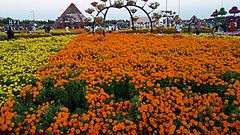
On February 14, 2013, the Dubai Miracle Garden, a 72,000-metre (236,000-foot) flower garden, opened in Dubailand. It is the world's largest flower garden. The garden has a total of 45 million flowers with re-use of waste water through drip irrigation. During the summer seasons from late May to September when the climate can get extremely hot with an average high of about 40 °C (104 °F), the garden stays closed.[150][151]
Transportation
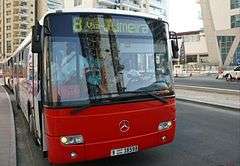
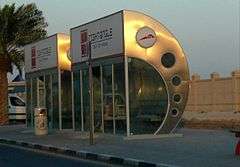
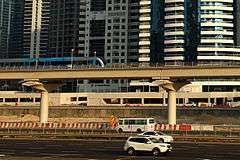
_AN1204297.jpg)
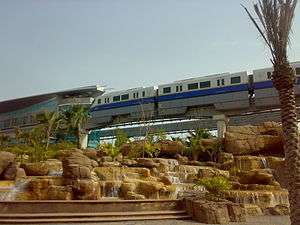
Transport in Dubai is controlled by the Roads and Transport Authority (RTA), an agency of the government of Dubai, formed by royal decree in 2005.[153] The public transport network has in the past faced congestion and reliability issues which a large investment programme has addressed, including over AED 70 billion of improvements planned for completion by 2020, when the population of the city is projected to exceed 3.5 million.[154] In 2009, according to Dubai Municipality statistics, there were an estimated 1,021,880 cars in Dubai.[155] In January 2010, the number of Dubai residents who use public transport stood at 6%.[156]
Road
Five main routes – E 11 (Sheikh Zayed Road), E 311 (Sheikh Mohammed Bin Zayed Road), E 44 (Dubai-Hatta Highway), E 77 (Dubai-Al Habab Road) and E 66 (Oud Metha Road) – run through Dubai, connecting the city to other towns and emirates. Additionally, several important intra-city routes, such as D 89 (Al Maktoum Road/Airport Road), D 85 (Baniyas Road), D 75 (Sheikh Rashid Road), D 73 (Al Dhiyafa Road now named as 2 December street), D 94 (Jumeirah Road) and D 92 (Al Khaleej/Al Wasl Road) connect the various localities in the city. The eastern and western sections of the city are connected by Al Maktoum Bridge, Al Garhoud Bridge, Al Shindagha Tunnel, Business Bay Crossing and Floating Bridge.[157]
The Public Bus Transport system in Dubai is run by the RTA. The bus system services 140 routes and transported over 109 million people in 2008. By the end of 2010, there will be 2,100 buses in service across the city.[158] In 2006, the Transport authority announced the construction of 500 air-conditioned (A/C ) Passenger Bus Shelters, and planned for 1,000 more across the emirates in a move to encourage the use of public buses.[159]
All taxi services are licensed by the RTA. Dubai licensed taxis are easily identifiable by their cream bodywork colour and varied roof colours identifying the operator. Dubai Taxi Corporation, a division of the RTA, is the largest operator and has taxis with red roofs. There are five private operators: Metro Taxis (orange roofs); Network Taxis (yellow roofs); Cars Taxis (blue roofs); Arabia Taxis (green roofs); and City Taxis (purple roof). In addition, Dubai Taxi Corporation has a Ladies Taxi service, with pink roofs, which caters exclusively for female passengers, using female drivers. The Dubai International Airport taxi concession is operated by Dubai Taxi Corporation. There are more than 3000 taxis operating within the emirate making an average of 192,000 trips every day, carrying about 385,000 persons. In 2009 taxi trips exceeded 70 million trips serving around 140.45 million passengers.[160][161][162]
Air
Dubai International Airport (IATA: DXB), the hub for Emirates Airlines and flydubai, serves the city of Dubai and other emirates in the country. The airport was the 7th busiest airport in the world by passenger traffic handling 70.4 million passengers in 2014. The airport is also the busiest airport in the world by international passenger traffic.[163] In addition to being an important passenger traffic hub, the airport is the 7th busiest cargo airport in world, handling 2.37 million tons of cargo in 2014[164] Emirates Airline is the national airline of Dubai. As of 2014, it operated internationally serving 142 destinations in over 70 countries across six continents.[165]
The development of Al Maktoum International Airport (IATA: DWC) was announced in 2004. The first phase of the airport, featuring one A380 capable runway, 64 remote stands, one cargo terminal with annual capacity for 250,000 tonnes of cargo and a passenger terminal building designed to accommodate five million passengers per year, has been opened.[166] When completed, Dubai World Central-Al Maktoum International will be the largest airport in the world with five runways, four terminal buildings and capacity for 160 million passengers and 12 million tons of cargo.[167]
Metro rail
A $3.89 billion Dubai Metro project is operational. It consists of two lines (Red line and Green line) which run through the financial and residential areas of the city. The Metro system was partially opened on September 2009.[168] UK-based international service company Serco is responsible for operating the metro. The metro comprises the Green Line, which has 20 stations (8 underground, 12 elevated) and runs from the Etisalat Station to the Creek Station and the Red Line, the major back bone line, which has 29 stations (4 underground, 24 elevated and 1 at ground level) and runs from Rashidiya Station to UAE Xchange Station Jebel Ali. A Blue and a Purple Line have also been planned. The Dubai Metro (Green and Blue Lines) will have 70 km (43.5 mi) of track and 43 stations, 37 above ground and ten underground.[169] The Dubai Metro is the first urban train network in the Arabian Peninsula.[152] All the trains run without a driver and are based on automatic navigation.
Palm Jumeirah Monorail
The Palm Jumeirah Monorail is a monorail line on the Palm Jumeirah. It connects the Palm Jumeirah to the mainland, with a planned further extension to the Red Line of the Dubai Metro.[170] The line opened on 30 April 2009.[171] Two tram systems are expected to be built in Dubai by 2011. The first is the Downtown Burj Khalifa Tram System and the second is the Al Sufouh Tram. The Downtown Burj Khalifa Tram System is a 4.6 km (2.9 mi) tram service that is planned to service the area around the Burj Khalifa, and the second tram will run 14.5 km (9.0 mi) along Al Sufouh Road from Dubai Marina to the Burj Al Arab and the Mall of the Emirates.
Tram
A tramway located in Al Sufouh, Dubai, will run for 14.5 kilometres (9.0 miles) along Al Sufouh Road from Dubai Marina to the Burj Al Arab and the Mall of the Emirates with two interchanges with Dubai Metro’s Red Line. The first section, a 10.6-kilometer (6.6 mi) long tram line which serves 11 stations, was opened on 11 November 2014, by H.H. Sheikh Mohammed bin Rashid Al Maktoum, The Vice-President and Prime Minister of UAE and Ruler of Dubai, with the line opening to the public at 6 am on 12 November 2014.[172]
High speed rail
Dubai has announced it will complete a link of the UAE high-speed rail system which will eventually hook up with the whole GCC (Gulf Cooperation Council, also known as Cooperation Council for the Arab States of the Gulf) and then possibly Europe. The High Speed Rail will serve passengers and cargo.[173]
Waterways
There are two major commercial ports in Dubai, Port Rashid and Port Jebel Ali. Port Jebel Ali is the world's largest man-made harbour, the biggest port in the Middle East,[174] and the 7th-busiest port in the world.[109] One of the more traditional methods of getting across Bur Dubai to Deira is by abras, small boats that ferry passengers across the Dubai Creek, between abra stations in Bastakiya and Baniyas Road.[175] The Marine Transport Agency has also implemented the Dubai Water Bus System. Water bus is a fully air conditioned boat service across selected destinations across the creek. One can also avail oneself of the tourist water bus facility in Dubai. Latest addition to the water transport system is the Water Taxi.[176]
Culture
The UAE culture mainly revolves around the religion of Islam and traditional Arab culture. The influence of Islamic and Arab culture on its architecture, music, attire, cuisine and lifestyle are very prominent as well. Five times every day, Muslims are called to prayer from the minarets of mosques which are scattered around the country. Since 2006, the weekend has been Friday-Saturday, as a compromise between Friday's holiness to Muslims and the Western weekend of Saturday-Sunday.[177]
The city's cultural imprint as a small, ethnically homogenous pearling community was changed with the arrival of other ethnic groups and nationals—first by the Iranians in the early 1900s, and later by Indians and Pakistanis in the 1960s. In 2005, 84% of the population of metropolitan Dubai was foreign-born, about half of them from India.[90]
Due to the touristic approach of many Dubaites in the entrepreneurial sector and the high standard of living, Dubai's culture has gradually evolved towards one of luxury, opulence and lavishness with a high regard for leisure-related extravagance.[178][179][180] Annual entertainment events such as the Dubai Shopping Festival[181] (DSF) and Dubai Summer Surprises (DSS) attract over 4 million visitors from across the region and generate revenues in excess of $2.7 billion.[182][183]
Major holidays in Dubai include Eid al Fitr, which marks the end of Ramadan, and National Day (2 December), which marks the formation of the United Arab Emirates.
The International Festivals and Events Association (IFEA), the world's leading events trade association, has crowned Dubai as IFEA World Festival and Event City, 2012 in the cities category with a population of more than one million.[184][185] Large shopping malls in the city, such as Deira City Centre, Mirdiff City Centre, BurJuman, Mall of the Emirates, Dubai Mall (the world's largest) and Ibn Battuta Mall as well as traditional Dubai Gold Souk and other souks attract shoppers from the region.
Food
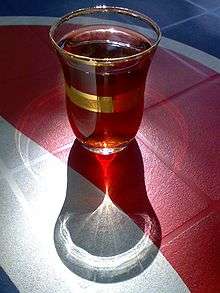
Arabic food is very popular and is available everywhere in the city, from the small shawarma diners in Deira and Al Karama to the restaurants in Dubai's hotels. Fast food, South Asian, and Chinese cuisines are also very popular and are widely available. The sale and consumption of pork, though legal, is regulated and is sold only to non-Muslims, in designated areas of supermarkets and airports.[186] Similarly, the sale of alcoholic beverages is regulated. A liquor permit is required to purchase alcohol; however, alcohol is available in bars and restaurants within hotels.[187] Shisha and qahwa boutiques are also popular in Dubai. Dubai is known for its nightlife. Clubs and bars are found mostly in hotels due to the liquor laws. The New York Times described Dubai as "the kind of city where you might run into Michael Jordan at the Buddha Bar or stumble across Naomi Campbell celebrating her birthday with a multiday bash".[188]
Biryani is also a popular cuisine across Dubai with being the most popular among Indians and Pakistanis present in Dubai.[189]
Dubai Food Festival
The inaugural Dubai Food Festival was held between 21 February to 15 March 2014.[190] According to Vision magazine, the event was aimed at enhancing and celebrating Dubai’s position as the gastronomic capital of the region. The festival was designed to showcase the variety of flavours and cuisines on offer in Dubai featuring the cuisines of over 200 nationalities at the festival.[191] The next food festival will be between 23 February 2017 to 11 March 2017.[192]
Entertainment
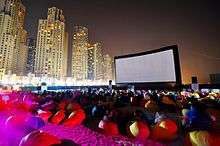
Hollywood and Indian movies are popular in Dubai (UAE). Since 2004, the city has hosted the annual Dubai International Film Festival which serves as a showcase for Arab film making talent.[193] Musicians Amr Diab, Diana Haddad, Aerosmith, Santana, Mark Knopfler, Rick Ross, Elton John, Pink, Shakira, Celine Dion, Coldplay, Lady Gaga, Jennifer Lopez, Justin Bieber, Selena Gomez and Roxette[194] have performed in the city.[187] Kylie Minogue was reportedly paid $3.5 million to perform at the opening of the Atlantis resort on 20 November 2008.[195] The Dubai Desert Rock Festival was also another major festival consisting of heavy metal and rock artists but is no longer held in Dubai.
Popular films set in Dubai include: Balram vs. Tharadas, Black Friday (2004 film), Body of Lies (film), Boom (film), City of Life, Deewane Huye Paagal, Dubai (2001 film), Dubai (2005 film), Glitter Dust: Finding Art in Dubai, Happy New Year (2014 film), Hungama in Dubai, Italians (film), Mission: Impossible – Ghost Protocol, Naqaab, Silver Bears (film), Switch (2013 film), Welcome (2007 film) and Kung Fu Yoga.
One of the lesser known sides of Dubai is the importance of its young contemporary art gallery scene. Since 2008, the leading contemporary art galleries such as Carbon 12 Dubai,[196] Green Art, gallery Isabelle van den Eynde, and The Third Line are bringing the city on the international art map. Art Dubai, the growing and reputable art fair of the region is as well a major contributor of the contemporary art scene's development.
The largest Cinema Hall in UAE is Reel Cinemas located at Dubai Mall.[197] It has 22 screens available with a total of 2800 seats.
Dubai Shopping Festival
The Dubai Shopping Festival is a yearly event in Dubai, It started in 1995, attracts a lot of visitors from worldwide to visit Dubai and get advantage of the sales during this festival.
In 2015 it started from 1 January and went until 1 February, but, The Department of Tourism and Commerce Marketing in Dubai announced the cessation of all entertainment and musical activities related to the Dubai Shopping Festival for 3 days, starting from Friday, 23 January to Sunday, 25 January due to the death of King Abdullah bin Abdulaziz former ruler of Saudi Arabia.[198]
Media


Many international news agencies such as Reuters, APTN, Bloomberg L.P. and Middle East Broadcasting Center (MBC) operate in Dubai Media City and Dubai Internet City. Additionally, several local network television channels such as Dubai One (formerly Channel 33), and Dubai TV (EDTV) provide programming in English and Arabic respectively. Dubai is also the headquarters for several print media outlets. Dar Al Khaleej, Al Bayan and Al Ittihad are the city's largest circulating Arabic language newspapers,[199] while Gulf News, Khaleej Times and 7DAYS are the largest circulating English newspapers.[200]
Etisalat, the government-owned telecommunications provider, held a virtual monopoly over telecommunication services in Dubai prior to the establishment of other, smaller telecommunications companies such as Emirates Integrated Telecommunications Company (EITC—better known as Du) in 2006. Internet was introduced into the UAE (and therefore Dubai) in 1995. The network has an Internet bandwidth of 7.5 Gbit/s with capacity of 49 STM1 links.[201] Dubai houses two of four Domain Name System (DNS) data centres in the country (DXBNIC1, DXBNIC2).[202] Censorship is common in Dubai and used by the government to control content that it believes violates the cultural and political sensitivities of Emirates.[203] Homosexuality, drugs, and the theory of evolution are generally considered taboo.[187][204]
Internet content is regulated in Dubai. Etisalat uses a proxy server to filter Internet content that the government deems to be inconsistent with the values of the country, such as sites that provide information on how to bypass the proxy; sites pertaining to dating, gay and lesbian networks, and pornography; and sites originating from Israel.[205] Emirates Media and Internet (a division of Etisalat) notes that as of 2002, 76% of Internet users are male. About 60% of Internet users were Asian, while 25% of users were Arab. Dubai enacted an Electronic Transactions and Commerce Law in 2002 which deals with digital signatures and electronic registers. It prohibits Internet Service Providers (ISPs) from disclosing information gathered in providing services.[206] The penal code contains official provisions that prohibit digital access to pornography; however, it does not address cyber crime or data protection.[207]
Sports
Football and cricket are the most popular sports in Dubai. Five teams (Al Wasl FC, Al-Ahli Dubai, Al Nasr SC, Al Shabab Al Arabi Club and Dubai Club) represent Dubai in UAE Pro-League.[187] Al-Wasl have the second-most number of championships in the UAE League, after Al Ain. Dubai also hosts both the annual Dubai Tennis Championships and The Legends Rock Dubai tennis tournaments, as well as the Dubai Desert Classic golf tournament and the Dubai World Championship, all of which attract sports stars from around the world. The Dubai World Cup, a thoroughbred horse race, is held annually at the Meydan Racecourse. Dubai also hosts the traditional rugby union tournament Dubai Sevens, part of the Sevens World Series Event pictures of Rugby 7 Dubai 2015. In 2009, Dubai hosted the 2009 Rugby World Cup Sevens. Auto racing is also a big sport in Dubai, the Dubai Autodrome is home to many auto racing events throughout the year. Cycling became one of the biggest sports in the UAE and Fun Ride Sports focus on cycling events and to be at all the races to provide world class events.
Cricket
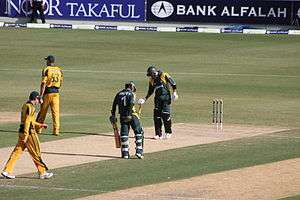
Cricket is followed by Dubai's large community of Indians and Pakistanis alongside the residents from other cricket playing nations (Sri Lanka, Bangladesh, England, Australia, South Africa and Nepal). In 2005, the International Cricket Council (ICC) moved its headquarters from London to Dubai. The city has hosted several Pakistan matches and two new grass grounds are being developed in Dubai Sports City. Numerous tournaments also take place in Dubai.[208] Since Pakistan played Australia in a One-Day International in Dubai in 2009, not only have top international teams competed in the city, but the emirate is helping to improve the standard of cricket around the world with the ICC Cricket Academy, a training and coaching facility which is used by the world’s leading nations. Board of Control for Cricket in India played some Indian Premier League matches here.
Education
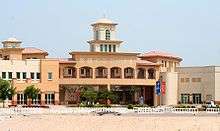
The school system in Dubai follows that of the United Arab Emirates. As of 2009, there are 79 public schools run by the Ministry of Education that serve Emiratis and expatriate Arab people as well as 145 private schools.[85] The medium of instruction in public schools is Arabic with emphasis on English as a second language, while most of the private schools use English as their medium of instruction. Most private schools cater to one or more expatriate communities.[209]
More than 15 schools offer an international education using the one or more of the four International Baccalaureate Programmes for students aged 3–19.[210] Several schools have introduced the new IB Career-related Programme that can be combined with a vocational qualification such as a BTEC.[211] The Abu Dhabi Education Council (ADEC) signed an agreement with the IB in efforts to widen the options offered for parents and to meet the different needs of students in the United Arab Emirates (UAE).[212]
Additionally a number of schools offer either a CBSE or an Indian Certificate of Secondary Education Indian syllabus. The Indian High School, DPS are some examples. Similarly, there are also several reputable Pakistani schools offering FBISE curriculum for expatriate children in Dubai.
A number of schools also offer British primary education up to the age of eleven. British style eleven-to-eighteen secondary schools offering General Certificate of Secondary Education and A-Levels include Dubai Gem Private School, Dubai British School, English Language School Pvt. Some schools, such as The American School of Dubai, also offer the curriculum of the United States.[213]
The most well-known universities in Dubai are American University in Dubai, Hult International Business School, Al Ghurair University, The American College of Dubai, University of Wollongong in Dubai, British University in Dubai offering courses in Business Administration, Engineering, Architecture and Interior Design. American University in Dubai is one of the six UAE universities featured in QS World University Rankings 2014/2015.[214] In 2013 Synergy University Dubai Campus[215] opened its campus in Jumeirah Lakes Towers being a first University in Dubai to be located outside of Educational Zones (Knowledge Village or Academic City).[216]
Healthcare

Healthcare in Dubai can be divided into two different sectors: public and private. Each Emirate is able to dictate healthcare standards according to their internal laws, although the standards and regulations rarely have extreme differences. Public hospitals in Dubai were first built in the late 1950s and continued to grow with public health initiatives. There are now 28 hospitals in Dubai, 6 public and 22 private, with 3 more major hospitals scheduled to be built by 2025.[217]
By the end of 2012, there were also a total of 1,348 medical clinics, 97% of which are operated privately.[218] In 2015, Dubai phased in mandatory health insurance for all inhabitants, thereby leading to increased demand for medical services.[219]
Notable people
International relations
Twin towns and sister cities
Dubai is twinned with the following cities:[220]
 Barcelona, Barcelona, Catalonia, Spain (2006)[221]
Barcelona, Barcelona, Catalonia, Spain (2006)[221] Beirut, Lebanon[222]
Beirut, Lebanon[222] Busan, South Korea (2006)[223]
Busan, South Korea (2006)[223] Detroit, Michigan, United States (2003)[224]
Detroit, Michigan, United States (2003)[224] Frankfurt, Hesse, Germany, as a Friendship city since 2005[225]
Frankfurt, Hesse, Germany, as a Friendship city since 2005[225] Gold Coast, Queensland, Australia (2001)[226]
Gold Coast, Queensland, Australia (2001)[226] Shanghai, China (2009)[227]
Shanghai, China (2009)[227] Istanbul, Turkey (1997)[228]
Istanbul, Turkey (1997)[228] Padang, Indonesia (2015)[229]
Padang, Indonesia (2015)[229]
See also
- Al Sufouh Archaeological Site
- Dubai Desert Conservation Reserve
- Dubai Silicon Oasis
- Jumeirah Lake Towers
- List of cities with most skyscrapers
- Sustainability in Dubai
Notes
- ↑ Area of "Dubai emirate", includes artificial islands.
- 1 2 "Global city GDP 2014". Brookings Institution. Archived from the original on 4 June 2013. Retrieved 18 November 2014.
- ↑ "United Arab Emirates: metropolitan areas". World-gazetteer.com. Archived from the original on 25 August 2009. Retrieved 31 July 2009.
- ↑ The Government and Politics of the Middle East and North Africa. D Long, B Reich. p.157
- ↑ "Where is Dubai and Dubai city?". Thatsdubai.com. 14 June 2007. Retrieved 12 March 2013.
- ↑ "The 2008 Global Cities Index". Foreign Policy. 15 October 2008. Archived from the original on 20 May 2010. Retrieved 20 April 2010.
- 1 2 3 Sampler & Eigner (2008). Sand to Silicon. UAE: Motivate. p. 11. ISBN 9781860632549.
- ↑ DiPaola, Anthony (28 September 2010). "Dubai gets 2% GDP from oil". Bloomberg.
- 1 2 Oil share dips in Dubai GDP AMEInfo (9 June 2007) Retrieved on 15 October 2007. Archived 26 September 2013 at the Wayback Machine.
- ↑ Dubai economy set to treble by 2015 ArabianBusiness.com (3 February 2007) Retrieved on 15 October 2007.
- 1 2 "Dubai diversifies out of oil". AMEInfo. 7 September 2005. Archived from the original on 19 December 2008. Retrieved 12 August 2008.
- ↑ Davis, Mike (September–October 2006). "Fear and money in Dubai". New Left Review. New Left Review. II (41): 47–68.
- 1 2 "Job losses hasten property decline in Dubai but medium-long term outlook upbeat". Propertywire.com. 3 December 2008. Retrieved 14 July 2009.
- ↑ "Mohammad Bin Rashid approves Dubai's budget for 2015". gulfnews.com. Retrieved 25 May 2015.
- ↑ Lucy Barnard and try www.Bttinternational.co.za for free escorts adverts in Durbia (6 March 2013). "Cost of living in Dubai rising rapidly – The National". Thenational.ae. Retrieved 12 March 2013.
- ↑ "Oslo, Zürich and Tokyo are most expensive cities". Thepeninsulaqatar.com. 14 September 2012. Archived from the original on 27 February 2015. Retrieved 12 March 2013.
- ↑ "Dubai second-most expensive city to stay in, report says". Retrieved 30 September 2014.
- ↑ Gillian Duncan (8 March 2013). "Abu Dhabi and Dubai are best places to live in the Middle East, survey says – The National". Thenational.ae. Retrieved 12 March 2013.
- ↑ Alkaabi, Alyazya (July 2011). مسميات مناطق دبي قديماً [Old names areas of Dubai]. Al Jundi (in Arabic). Ministry of Defense. 444: 76.
- ↑ "Old Dubai". Archived from the original on 3 February 2014. Retrieved 24 January 2014.
- ↑ "How Did Dubai, Abu Dhabi and other Cities Get Their Names? Experts Reveal All". UAE Interact. 30 March 2007. Retrieved 24 January 2014.
- ↑ Tahir, Mohammad A., et al. "Distribution of HLA-DQA1 alleles in Arab and Pakistani individuals from Dubai, United Arab Emirates." Forensic science international 85.3 (1997): 219-223.
- 1 2 3 "History and Traditions of the UAE" (PDF). Retrieved 31 July 2009.
- ↑ "The old ... turned new". Travel & Culture. 25 October 2001. Retrieved 15 March 2008.
- 1 2 Ibrahim Al Abed, Peter Hellyer (2001). United Arab Emirates: A perspective. Trident Press. ISBN 978-1-900724-47-0. Retrieved 31 July 2009.
- 1 2 "The Coming of Islam and the Islamic Period in the UAE. King, Geoffrey R." (PDF). Retrieved 20 April 2013.
- 1 2 Heard-Bey, Frauke (1990). From Trucial States to United Arab Emirates. UK: Longman. p. 238. ISBN 0582277280.
- ↑ Schofield, R (1990). Islands and Maritime Boundaries of the Gulf 1798–1960. UK: Archive Editions. p. 545. ISBN 9781852072759.
- 1 2 "Modernity and tradition in Dubai architecture. Karim, Luiza". Alshindagah.com. Retrieved 31 July 2009.
- 1 2 Davidson, Christopher, The Emirates of Abu Dhabi and Dubai: Contrasting Roles in the International System. March 2007.
- 1 2 3 "Dubayy". Encyclopædia Britannica. 2008
- ↑ "The UAE: Internal Boundaries And The Boundary With Oman. Archived Editions. Walker, J". Archiveeditions.co.uk. 18 February 1969. Retrieved 20 April 2013.
- ↑ The Middle East and North Africa. Schofield, C. p 175
- 1 2 3 Wilson, Graeme (1999). Father of Dubai. UAE: Media Prima. p. 126. ISBN 9789948856450.
- ↑ Wilson, Graeme (2008). Fly Buy Dubai. UAE: Media Prima. p. 58. ISBN 9789948859437.
- 1 2 "Historic population statistics" (PDF). Retrieved 31 July 2009.
- ↑ Chapman, Len. "How Chicago Beach got its name...then lost it!". Dubai As It Used To Be. Retrieved August 20, 2016.
- ↑ Wilson, Graeme (1999). Father of Dubai. UAE: Media Prima. p. 151. ISBN 9789948856450.
- ↑ Al Maktoum, Mohammed bin Rashid (2012). Spirit of the Union. UAE: Motivate. pp. 27–39. ISBN 9781860633300.
- ↑ Maktoum, Mohammed bin Rashid (2012). Spirit of the Union. UAE: Motivate. p. 30. ISBN 9781860633300.
- ↑ "Beirut Showing Signs of Recovery From Wounds of War". The New York Times. 26 May 1977. pg.2
- ↑ Dubai. Carter, T and Dunston, L. Lonely Planet Publications
- ↑ "Free Zones in the UAE". uaefreezones.com. Retrieved 23 April 2010.
- ↑ Sampler & Eigner (2008). Sand to Silicon: Going Global. UAE: Motivate. p. 15. ISBN 9781860632549.
- ↑ Environmental Development and Protection in the UAE. Aspinall, Simon
- 1 2 Far enough from the fault lines. The National, 23 April 2008
- ↑ Flora and fauna of Dubai gowealthy.com
- ↑ Natural UAE UAE Interact Retrieved 29 April 2010
- ↑ "Climate in Dubai across the year. Dubai Meteorological office". Dubaiairport.com. Archived from the original on 18 December 2010. Retrieved 20 April 2013.
- ↑ "Temperature and Humidity in Dubai". Godubai.com. Retrieved 20 April 2013.
- ↑ "UAE weather: Temperature soars to near record level". thenational.ae. Retrieved 18 May 2014.
- ↑ "Climate (Average Temperatures:1984-2009;Precipitation:1967-2009)". Dubai Meteorological Office. Retrieved 20 December 2008.
- ↑ "Dubai, Emirates". Climatebase.ru. Retrieved 10 February 2013.
- ↑ "Climate Normals for Dubai". National Oceanic and Atmospheric Administration. Retrieved 10 February 2013.
- ↑ "Monthly Dubai water temperature chart". Seatemperatures.org. Retrieved 2014-01-20.
- ↑ US Library of Congress – Legislative Branches
- ↑ Organizational Chart. Dubai Municipality
- ↑ Dubai Municipality's e-government initiative. Powerpoint. 2 December 2005
- ↑ Wheeler, Julia (13 October 2008). "Raw sewage threat to booming Dubai". BBC News. Retrieved 31 July 2009.
- ↑ "The UAE now has a Minister of Happiness – What's On Dubai". What's On Dubai. Retrieved 2016-03-27.
- ↑ On the United Arab Emirates (UAE) Legal System. Gulf-Law.com
- ↑ UAE Consulate of the United States
- ↑ "Ask Ali: Kissing in public, renting a flat and the rababah – The National".
- ↑ "Jailed Dubai kissing pair lose appeal over conviction".
- ↑ "London man tells of 'shock' jailing in Dubai over kiss". 5 July 2010.
- ↑ Za'za, Bassam (25 May 2008). "Women get jail and deportation for kissing on Dubai public beach". gulfnews.
- ↑ Etihad Airways (20 March 2014). "A Surprise Proposal on Etihad Airways" – via YouTube.
- ↑ http://english.alarabiya.net/en/perspective/features/2014/05/04/Nose-kiss-anyone-How-the-Gulf-Arab-greeting-has-evolved.html
- ↑ Alcohol / liquor licence and laws in Dubai
- ↑ "Criminal Law of Dubai".
- ↑ The Associated Press (22 July 2013). "Dubai Pardons Woman at Center of Rape Dispute". New York Times. Retrieved 22 July 2013.
- ↑ "Human Rights Watch – Building Towers, Cheating Workers: Exploitation of Migrant Construction Workers in the United Arab Emirates". Retrieved 4 October 2014.
- ↑ Human Rights Watch. Building Towers, Cheating Workers: Exploitation of Migrant Construction Workers in the United Arab Emirates (PDF) (PDF ed.). Retrieved 2016-02-12.
- ↑ "UAE to allow construction unions". BBC News. 30 March 2006.
- ↑ "Dubai fire investigation launched". BBC News. 19 January 2007.
- ↑ "Slaves in Dubai documentary". VICE. 2009. Retrieved 18 February 2013.
- ↑ "UAE to allow construction unions". BBC News. 30 March 2006. Retrieved 24 April 2006.
- 1 2 Karin, Luiza (September 1999). "Modernity and tradition in Dubai architecture by Luiza Karim". alshindagah.com. Retrieved 19 April 2010.
- ↑ Hadjari, Karim. "3D Modelling and Visualisation OF Al Baskita in Dubai IN Dubai, United Arab Emerites" (PDF). Retrieved 19 April 2010.
- ↑ "Tourism in Dubai" (PDF). Retrieved 19 April 2010.
- ↑ Lahmeyer, Jan (2001). "The United Arab Emigrates – Historical demographical data of the urban centers". .populstat. Retrieved 19 April 2010.
- ↑ Heard-Bey, Frauke. "The Tribal Society of the UAE and its Traditional Economy" (PDF). uaeinteract.com. Retrieved 19 April 2010.
- ↑ "Census 2005 U.A.E.". tedad.ae. Archived from the original on 16 May 2010. Retrieved 19 April 2010.
- 1 2 Younes, Bassem. "Roundabouts vs. Intersections: The Tale of Three UAE Cities" (PDF). ite.org. Retrieved 19 April 2010.
- 1 2 "Dubai in Figures 2009. Government of Dubai. Statistical Center". Dsc.gov.ae. Archived from the original on 20 April 2010. Retrieved 31 October 2010.
- ↑ "Cost of living – The world's most expensive cities". City Mayors. Retrieved 2016-02-12.
- ↑ "Dubai population jumps 4.8 per cent to 2.17m". UAE interact. Archived from the original on 19 August 2014. Retrieved 4 September 2014.
- ↑ "Call to naturalise some expats stirs anxiety in the UAE". Reuters UK.
- ↑ "GCC Citizenship Debate: A Place To Call Home". Gulf Business.
- 1 2 "Country and Metropolitan Stats in Brief. MPI Data Hub
- ↑ HASSAN M. FATTAH; Nada El Sawy contributed reporting for this article. (4 December 2005). "Young Iranians Follow Dreams to Dubai". Select.nytimes.com. Retrieved 11 September 2013.
- 1 2 "HSBC Reveals "The Future of Retirement: What the World Wants" Survey Results" (PDF). HSBC. 26 April 2006. Archived from the original (PDF) on 4 December 2008. Retrieved 19 April 2010.
- ↑ "Dubai leads British exodus overseas". Arabian Business. 21 May 2008. Retrieved 16 November 2012.
- ↑ "United Arab Emirates Demographics Profile 2014". www.indexmundi.com. Retrieved 2015-12-21.
- ↑ Christensen, Shane (2010). Frommer's Dubai. John Wiley & Sons. p. 174. ISBN 978-0-470-71178-1.
- ↑ "Nama Tuluveru all set to entertain UAE with Rangabhoomi's 'Kaala Chakra'". daijiworld.com. Retrieved 2016-02-12.
- ↑ "Languages spoken in Dubai". Justlanded.com. Retrieved 20 April 2013.
- 1 2 Country Profile: United Arab Emirates (UAE). United States Library of Congress
- ↑ "Report on International Religious Freedom". U.S. Department of State. Retrieved 30 September 2014.
- ↑ Religion in Dubai. Dubaidreams
- ↑ "International Religious Freedom Report 2007 – United Arab Emirates". State.gov. Retrieved 31 July 2009.
- ↑ Everington, John (22 January 2015). "Dubai enters top five ranked fastest growing economies". The National. Retrieved 24 March 2015.
- ↑ "Dubai's gross domestic product is expected to reach US$107.1 billion, posting a growth rate of 6.1% in 2014 and exceeding Dubai government's estimates of 5%, according to Citibank.". Zawya Thomson Reuters. 14 June 2014. Retrieved 24 March 2015.
- ↑ "Dubai – Overview". USA Today. Retrieved 22 July 2007.
- ↑ "Dubai's oil discovery and Dubai's debt". Moneycontrol.com. 5 February 2010. Retrieved 20 April 2013.
- ↑ "UAE Oil and Gas". Uae.gov.ae. 19 June 1999. Archived from the original on 5 July 2008. Retrieved 31 July 2009.
- ↑ Prospects of Dubai Economic Sectors Archived 16 February 2008 at the Wayback Machine.. Dubai Chamber of Commerce. 2003
- 1 2 "Dubai's foreign trade steady at Dh1.331 trillion in 2014". Emirates 24|7. 23 March 2015. Retrieved 24 March 2015.
- 1 2 "World Port Rankings – 2008" (PDF). American Association of Port Authorities. 15 April 2008. Retrieved 5 May 2010.
- ↑ "Free Zone Authorities in Dubai". Business-Dubai.com. Retrieved 15 November 2015.
- ↑ Armitstead, Louise (20 November 2008). "Dubai's Palm Jumeirah sees prices fall as crunch moves in". The Daily Telegraph. UK. Retrieved 20 November 2008.
- ↑ "World's Tallest Hotel Opens Its Doors". BBC News. 1 December 1999. Retrieved 31 July 2009.
- ↑ "Dubai: The Good, The Bad and The Ugly". Dubai: The Good, The Bad and The Ugly. 17 March 2012. Retrieved 17 March 2012.
- ↑ "Laid-Off Foreigners Flee as Dubai Spirals Down" article by Robert F. Worth in The New York Times 11 February 2009
- ↑ Hanif, Nadeem (12 November 2009). "JLT owners still waiting for homes promised in 2007". gulfnews.com. Retrieved 10 April 2012.
- ↑ Warner, Jeremy (27 November 2009) Dubai is just a harbinger of things to come for sovereign debt. The Telegraph
- ↑ "How Dubai real estate can avoid repeating past mistakes | Bayut Blog". Blog.bayut.com. 1 March 2013. Retrieved 10 September 2013.
- ↑ gold-dubai (22 February 2016) "Gold rate in Dubai".
- ↑ "Citgy Mayors: World's best financial cities". Citymayors.com. 10 June 2008. Retrieved 26 August 2009.
- ↑ "World's richest cities by purchasing power". City Mayors. Retrieved 23 June 2013.
- ↑ MW-IndexRpt-CoComm FA.indd
- ↑ "Laws & Regulations | Dubai International Financial Centre (DIFC)". www.difc.ae. Retrieved 2016-10-16.
- ↑ "Hot Spots 2025: Dubai Moves Up to 23rd Place Dubai Chronicle". Dubaichronicle.com. 2 July 2013. Retrieved 10 September 2013.
- ↑ "Indians top foreign investors in Dubai realty". The Times of India. Retrieved 10 September 2013.
- ↑ "Dubai Fashion 2020 To Be Unveiled Soon Dubai Chronicle". Dubaichronicle.com. 18 June 2013. Retrieved 10 September 2013.
- ↑ "Construction of 10 buildings in Dubai Design District already underway". Dubaichronicle.com. 9 June 2013. Retrieved 10 September 2013.
- ↑ "Bargain-hunting Fashionistas Descend onto Dubai". Bargain-hunting Fashionistas Descend onto Dubai. 17 March 2012. Retrieved 17 March 2012.
- ↑ "Shopping in Dubai". Shopping Galore in Dubai. 17 October 2013. Archived from the original on 17 October 2013. Retrieved 17 October 2013.
- ↑ Jacobs, Deborah L. "Most Visited Cities In The World 2013". Forbes. Archived from the original on 20 March 2014. Retrieved 19 March 2014.
- ↑ : Raj (3 March 2009). "Dubai can achieve 15m tourist target by 2015 – expert". Arabianbusiness.com. Retrieved 20 April 2013.
- ↑ Jacobs, Deborah L. "Most Visited Cities In The World 2012". forbes. Retrieved 2 December 2013.
- ↑ "Dubai History". dubai.ae. Retrieved 2 December 2013.
- ↑ "Dubai Creek for World Heritage List". Khaleej Times. Retrieved 2 December 2013.
- ↑ Krane, Jim (September 2009). City of Gold: Dubai and the Dream of Capitalism. St. Martin's Press. ISBN 978-0-312-53574-2.
- ↑ "Dubai Creek Park". Capture Dubai. Retrieved 2016-02-12.
- ↑ "Dubai Expo 2020 Master Plan". dubaichronicle.com. 22 May 2013. Retrieved 23 June 2013.
- ↑ Kerr, Simeon. "Jubilant Dubai wins bid to host 2020 World Expo". Financial Times. Retrieved 7 March 2014.
- ↑ "According to a research from Oxford Economics, Dubai Expo 2020 may create over 270,000 jobs". dubaichronicle.com. 24 May 2013. Retrieved 23 June 2013.
- ↑ "EXPO Dubai 2020 – a preview". Inexhibit magazine. Archived from the original on 17 February 2016. Retrieved 2016-02-09.
- ↑ "Dubai launches world's largest concentrated solar power project – Gulf Business". gulfbusiness.com. 2 June 2016.
- ↑ "UAE Gears Up Ahead of Dubai EXPO 2020". shuraa.com.
- ↑ Karim, Luiza Modernity and tradition in Dubai architecture. AlShindagah, 1999
- ↑ "Design of Burj Khalifa". Burjkhalifa.ae. Archived from the original on 28 February 2011. Retrieved 20 April 2013.
- ↑ "World's Ten Tallest Cities In 2012, the JW Marriott Marquis Dubai opened and is the World's tallest hotel, standing at 72 stories (1,165 ft).". Ultrapolis Project. Retrieved 3 November 2010.
- ↑ "Calculated Average Height of the Twenty-five Tallest (CAHTT)". Ultrapolisproject.com. 4 January 2010. Retrieved 20 April 2013.
- ↑ "Burj Khalifa records over 1.87 million visitors in 2013.". khaleejtimes.com.
- ↑ "Hotel star ratings standards long overdue". The National. 14 July 2009. Retrieved 10 December 2010.
- ↑ "Dubai In Number", go-gulf.ae, 23 March 2015. Retrieved on 25 March 2015
- ↑ "Iosif Stalin-2", capturedubai.com, 29 March 2015. Retrieved on 30 March 2015.
- ↑ "World's Largest Natural Flower Garden Opens in Dubai". 13 March 2013. Archived from the original on 8 March 2013.
- ↑ "The World's most beautiful garden-In Dubai". Xpress. 20 February 2013.
- 1 2 "Will metro change Dubai car culture?". BBC News. 11 September 2009.
- ↑ http://www.rta.ae
- ↑ "Gulfnews: Dubai traffic woes inflict losses of Dh4.6b a year". Archive.gulfnews.com. Retrieved 14 July 2009.
- ↑ "Gulfnews: Public transport regains allure as Car-free Day gets under way". Archive.gulfnews.com. 17 February 2010. Retrieved 29 April 2010.
- ↑ "Gulfnews: Rta wants 30 of dubai residents on public transport". Archive.gulfnews.com. 21 January 2010. Retrieved 29 April 2010.
- ↑ Completed projects. RTA Dubai
- ↑ "Dubai buses may be privatised – The National Newspaper". Thenational.ae. 8 June 2009. Retrieved 14 July 2009.
- ↑ "Gulfnews: Air-conditioned bus shelters for Dubai". Archive.gulfnews.com. 6 March 2010. Retrieved 10 March 2006.
- ↑ "Gulfnews: Dubai Metro gives boost to public transport in city". Archive.gulfnews.com. 6 March 2010. Retrieved 29 April 2010.
- ↑ "Dubai Taxi Corporation". Dtc.dubai.ae. 29 September 2010. Retrieved 31 October 2010.
- ↑ "Getting Around in Dubai". dubai.com/. Retrieved 14 September 2011.
- ↑ "2008 Annual Report". Dubai Airport. 2009. Archived from the original on 11 January 2010. Retrieved 28 February 2009.
- ↑ "DXB Takes Over Top Spot for International Passenger Traffic". dubaiairports.ae.
- ↑ "Our Destinations". Emirates.
- ↑ "Al Maktoum International airport begins operations". Gulf News. 27 June 2010. Retrieved 28 June 2010.
- ↑ "Al Maktoum International airport receives first flight". Gulf News. 21 June 2010. Retrieved 21 June 2010.
- ↑ "Dubai RTA – Dubai Metro – Blue Line". zawya. 11 September 2009. Archived from the original on 17 June 2011.
- ↑ "Dubai Municipality signs Dhs12.45 billion Metro contract". UAE Interact. 30 May 2005. Archived from the original on 13 May 2011.
- ↑ "Middle East's first monorail to start services in Palm Jumeirah by April". Gulf News. 7 August 2008. Archived from the original on 16 July 2009. Retrieved 11 August 2008.
- ↑ "Palm monorail tried and tested". Timeoutdubai. 6 May 2009. Retrieved 29 August 2010.
- ↑ "About". The Dubai Tram. Retrieved 2016-02-12.
- ↑ "GCC Rail Network". zawya projects. 14 April 2010. Archived from the original on 17 June 2011. Retrieved 25 April 2010.
- ↑ "Port of Jebel Ali". worldportsource.com. 14 August 2008. Retrieved 25 April 2010.
- ↑ Abra-services dubai-online
- ↑ "RTA launches Water Bus System on Dubai Creek". AMEinfo. 16 July 2007. Archived from the original on 2 June 2010. Retrieved 25 April 2010.
- ↑ Jonathan Sheikh-Miller. "UAE Weekend Switchover". AMEinfo. Archived from the original on 12 February 2011. Retrieved 22 March 2010.
- ↑ Luxury Fashion Branding: Trends, Tactics, Techniques – Page 80, Uché Okonkwo – 2007
- ↑ Dubai – Page 100, Terry Carter – 2009
- ↑ Introduction to Sociology – Page 14, George Ritzer – 2012
- ↑ Dubai Shopping Festival 2011 More Details
- ↑ DSF Milestones. Dubaicityguide
- ↑ "Sales will account for 8% of Dubai's GDP". Gulfnews.com. 3 May 2009. Archived from the original on 8 May 2013. Retrieved 20 April 2013.
- ↑ "Dubai is world's festival city". khaleejtimes.com. 23 September 2012. Retrieved 30 September 2012.
- ↑ "Dubai crowned World Festival and Event City by IFEA". news.definitelydubai.com. 23 September 2012. Retrieved 30 September 2012.
- ↑ Food and Agricultural Import Regulations and Standards. GAIN Report. United States Department of Agriculture Archived 26 February 2008 at the Wayback Machine.
- 1 2 3 4 Dubai Culture dubai-livethedream.com Archived 6 March 2010 at the Wayback Machine.
- ↑ Sherwood, Seth (9 December 2007). "Clubs Bloom in the Desert". The New York Times. Retrieved 23 April 2010.
- ↑ "Biryani in Dubai". zomato.com.
- ↑ "Dubai Food Festival". Dubai Food Festival. Archived from the original on 15 November 2014. Retrieved 20 November 2014.
- ↑ East, Ben (February 2014). "Taste of culture: Dubai Food Festival". Vision.ae. Retrieved 20 November 2014.
- ↑ "Dubai Food Festival 2017".
- ↑ "About Dubai Film Festival (DFF)". 7th Dubai International Film Festival. Archived from the original on 22 August 2008. Retrieved 23 April 2010.
- ↑ "du sponsors AR Rahman Live in Concert". ameinfo.com. 16 April 2008. Archived from the original on 8 November 2010. Retrieved 25 April 2010.
- ↑ Ferris-Lay, Claire (11 September 2008). "Kylie 'being paid $3.5mn' for Atlantis gig". Arab Business.com. Retrieved 23 April 2010.
- ↑ "Carbon 12's website". Carbon12dubai.com. 18 January 2013. Retrieved 20 April 2013.
- ↑ "Cinema at Dubai Mall". yagulf.com. Retrieved 2016-02-12.
- ↑ "DSF to halt all entertainment, musical activities to mourn Saudi king's death". Khaleej Times.
- ↑ Largest-Circulation Arabic Newspapers. Carnegie Endowment for International Peace. Arab Reform Bulletin, December 2004
- ↑ Gulf News continues to lead the way. zawya. February 2010
- ↑ "Etisalat ramps up UAE bandwidth". arabianbusiness.com. 11 June 2006. Retrieved 3 May 2010.
- ↑ Hashim, Abdulla (5 May 2005). "UAEnicat a Glance" (PDF). isoc.org. Retrieved 21 April 2010.
- ↑ United Arab Emirates. OpenNet Interactive. 2008
- ↑ Jack, Malvern (16 February 2009). "Geraldine Bedell's novel banned in Dubai because of gay character". The Times. UK. Retrieved 22 April 2010.
- ↑ "Internet Filtering in the United Arab Emirates in 2004–2005: A Country Study". OpenNet Initiative. 5 May 2005. Retrieved 9 June 2010.
- ↑ "Electronic Transactions and Commerce Law No.2/2002". Dubai Technology and Media Free Zone Authority. Archived from the original on 31 May 2011. Retrieved 9 June 2010.
- ↑ "Silenced – United Arab Emirates". Privacyinternational.org. 21 September 2003. Archived from the original on 3 September 2010. Retrieved 20 April 2013.
- ↑ "ICC moves to new headquarters in Sports City". Gulfnews.com. 18 April 2009. Retrieved 20 April 2013.
- ↑ Mansell, Warwick (30 April 2010). "Expat guide to the UAE: schools". The Daily Telegraph. London.
- ↑ "Middle East International Baccalaureate Association (MEIBA) of Schools".
- ↑ "Welcome to BTEC".
- ↑ "ADEC signs a protocol agreement with the International Baccalaureate Organization today". ADEC. Retrieved 2016-02-12.
- ↑ "List of schools in Dubai, Dubai school finder". Dubaifaqs.com. 5 June 2012. Retrieved 20 April 2013.
- ↑ "QS World University Rankings® 2014/15". topuniversities.com. Retrieved 2016-02-12.
- ↑ Synergy University Dubai Campus. "Synergy University Dubai Campus – Home Page". Synergy University Dubai Campus. Retrieved 2016-02-12.
- ↑ DEG. "Synergy University, Dubai Educational Guide". Retrieved 2016-02-12.
- ↑ "UAE Expo 2020 bid in good health: Dubai gets new hospitals". 19 August 2013.
- ↑ "Dubai Healthcare Overview". Colliers.
- ↑ "Dubai's mandatory health insurance law comes into force". The National. 15 February 2014.
- ↑ "Dubai's sister cities". Dubai, AUE: dubaicityguide. Retrieved 16 February 2015.
- ↑ Dubai is sister city to Barcelona, on the municipality's website (in Catalan), retrieved on 28 October 2015.
- ↑ International Travel Tours (n.d) "Dubai Sister Cities" http://www.international-travel-tours.com/dubai/sister-cities.html
- ↑ Dubai and Busan are sister cities, on the municipality's website Archived 5 January 2016 at the Wayback Machine., 13 November 2006.
- ↑ Sister Cities Agreement between Detroit and Dubai, 28 September 2003.
- ↑ "Partnerships: Frankfurt am Main" (in German). Council of European Municipalities and Regions. Retrieved 16 February 2015.
- ↑ Dubai and Gold Coast are sister cities, on the municipality's website. Retrieved on 28 October 2015.
- ↑ Dubai is sister city to Shanghai, on the municipality's site , 27 July 2009.
- ↑ Dubai and Istanbul are sister cities, on the municipality's website (in Turkish), 22 March 1997.
- ↑ "Wako: Kerjasama Padang-Perth-Dubai Saling Menguntungkan". ANTARA (in Indonesian). 2015-09-15. Retrieved 2015-12-27.
References
- Syed Ali. Dubai: Gilded Cage (Yale University Press; 2010) 240 pages. Focuses on the Arab emirate's treatment of foreign workers.
- Heiko Schmid: Economy of Fascination: Dubai and Chicago as Themed Urban Landscapes, Berlin, Stuttgart 2009, ISBN 978-3-443-37014-5.
- John M. Smith: Dubai The Maktoum Story, Norderstedt 2007, ISBN 3-8334-4660-9.
External links
 Dubai travel guide from Wikivoyage
Dubai travel guide from Wikivoyage- www.Dubai.ae – Dubai Government official website
- www.DM.gov.ae – Dubai Municipality website
 |
Persian Gulf |  | ||
| |
Sharjah | |||
| ||||
| | ||||
| Abu Dhabi |
